Ivan Nikitovich Kozhedub and his fighters - La-5 and La-7
Ivan Nikitovich Kozhedub was born on June 8 of 1920 in a peasant family in a small Ukrainian village of Obrazhievka, Shostka District, Sumy Oblast. Later he graduated from the Chemical Technology College and Shostka Aero Club. In the Red Army hit the 1940 year. In 1941, he graduated from the Chuguev Military Aviation Pilot School, where he served as an instructor. Since the beginning of World War II, Ivan Kozhedub, along with the aviation school, was evacuated to Central Asia. After filing numerous reports with a request to send him to the front, his desire was granted. In November, 1942, Sergeant Ivan Kozhedub, arrived at the disposal of the 240 Fighter Regiment (IAP) of the emerging 302 Fighter Air Division. In March 1943, units of the division were sent to the Voronezh Front.
His first combat sortie, the future ace and the Hero of the Soviet Union spent 26 on March, the flight ended unsuccessfully: his fighter La 5 (onboard number 75) was damaged in battle, and when returning to the airfield, he was also fired by his anti-aircraft artillery. With great difficulty, the pilot was able to bring the car to the airfield and land. After that, for about a month I flew old fighters until I received a new La-5 again.
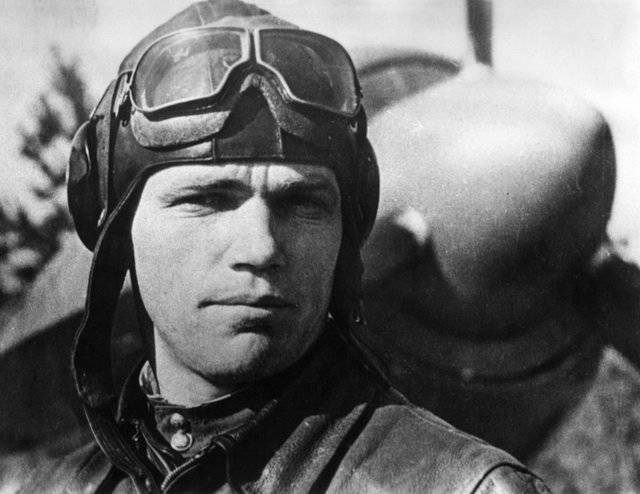
Pilot account of his victories as an ace pilot opened July 6 1943 on the Kursk Bulge, shooting down a dive bomber Ju-87. The very next day, Kozhedub won a second aerial victory, knocking down another Ju-87, and in July 9 was able to shoot down German Me-2 fighters right away in July. Already in August 109, Ivan Kozhedub became commander of the squadron. The first title of Hero of the Soviet Union with the award of the Order of Lenin and the Gold Star medal squadron commander 1943-IAP Senior Lieutenant Ivan Kozhedub received 240 February 4 of the year for 1944 sorties, in which he shot down 146 German aircraft.
From May 1944, Kozhedub fought on a new modification of the Lavochkin fighter - La-5FN (onboard No. 14), which was built with the money of the collective farmer from the Stalingrad region V.V. Konev. Within a few days after receipt, he knocks on it Ju-87. Over the next six days, the ace pilot scored another 7 of enemy aircraft. At the end of June, he sends his fighter KA. Evstigneev (later twice Hero of the Soviet Union), and he goes into the training regiment. But already in August, Ivan Kozhedub was appointed deputy commander of the 176 Guards Regiment of the IAP. At the same time, the regiment was in the process of rearmament, receiving new fighters La-7. The pilot-asu got the plane with the airborne number 27. Ivan Kozhedub will fly it until the very end of the war.
Captain Ivan Kozhedub was awarded the Second Gold Star Medal of the Guard to 19 on August 1944 of the year for 256 completed sorties, in which he personally shot down 48 German aircraft. Once during the air battle on the La-7 fighter, which passed over enemy territory, the Kozhedub aircraft was shot down. By car, the engine stalled and Ivan Kozhedub, in order not to surrender to the Germans, chose a target for himself on the ground and began to dive at it. When only a little time left before the ground, the fighter's engine suddenly started working again and Kozhedub was able to get the car out of a dive and returned safely to the airfield.
12 February 1945 years Ivan Kozhedub paired with his slave lieutenant V.A. Gromakovsky patrolled the space above the front edge, being in the "free hunting" mode. Having found a group of X-NUMX fighters FW-13, Soviet pilots immediately attacked them, knocking down German X-NUMX fighters. Three of them were recorded by Ivan Kozhedub, two - Gromakovsky. 190 February 5 of the year in flight over the Oder Kozhedub was able to shoot down a German Me-15 fighter jet, which was operated by non-commissioned officer K. Lyang from I./KG(J)1945.
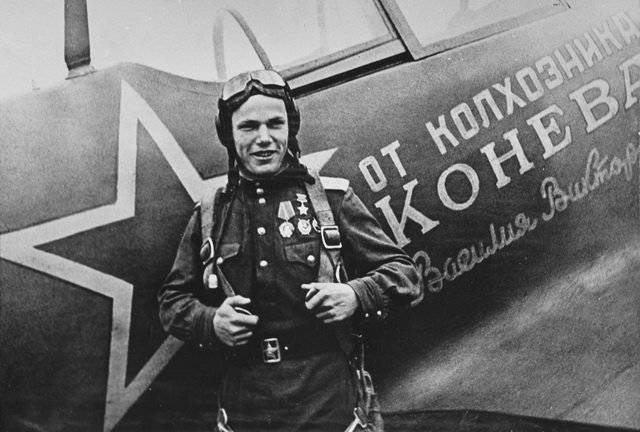
By the end of the Great Patriotic War, Guard Major Ivan Kozhedub made 330 sorties and conducted 120 air battles, shooting down 64 of the enemy aircraft. This number does not include the X-NUMX American fighter P-2 Mustang, which the Soviet ace shot down in the spring of 51. In this case, the Americans first attacked the fighter La-1945, which was operated by the Soviet pilot. According to the American pilot who survived this air battle, they confused Kozhedub La-7 with the German fighter FW-7 and attacked him. The third “Golden Star” Ivan Nikitovich Kozhedub received after the war for high military skills, personal courage and bravery.
Among the enemy planes shot down by Ivan Kozhedub were:
21 Fighter FW-190;
Me-18 fighter 109;
18 Ju-87 bombers;
3 attack aircraft Hs-129;
2 bomber He-111;
1 Fighter PZL P-24 (Romanian);
1 jet aircraft Me-262.
La 5 and La 5FN
La-5 - is a single-engine wooden nizkoplan. As with the fighter LaGG-3, the main structural material used in the airframe was pine. For the production of some of the frames and wing spars used Delta-wood. The wooden details of the aircraft skin were glued using special carbamide KM-1 or resin adhesive VIAM-B-3.
The wing of the aircraft, recruited from the NACA-23016 and NACA-23010 profiles, was technologically subdivided into a center-section and 2-two-arm consoles, which had a plywood trim. The main chassis posts joined the metal pipe with the aid of the end rib. Between the side members of the center section were caissons for gas tanks, glued out of plywood, and domes for the wheels of the chassis were located in the nose.
aircraft spars were made of wood with special shelves delta-wood (on the fighters modification La 5FN, since 1944 years, mounted metal spars.) to the console with plywood sheathing join automatic slats, ailerons such as "Fries" with duralumin frame sheathed percale and flaps, type "Shrenk". The left aileron had a trimmer.
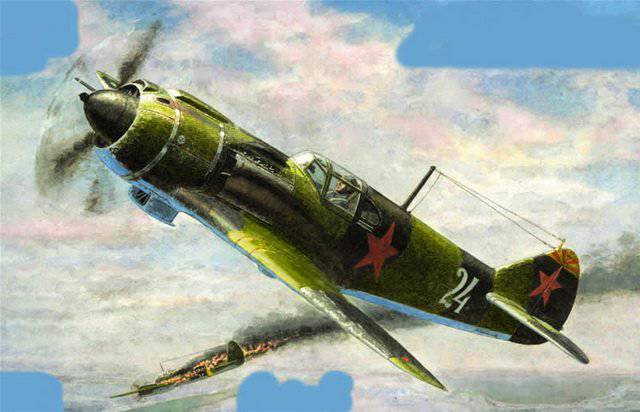
The fuselage of the fighter consisted of a wooden monocoque made in one piece with the keel and the front metal truss. The framework consisted of 15 frames and 4 spars. The fuselage of the fighter was tightly fastened to the center section of the 4-I steel nodes. The cockpit was closed by a plexiglass sliding light, which could stop in closed and open positions. On the frame behind the back of the pilot's seat was an armor plate with a thickness of 8,5 mm.
The stabilizer is two-spar, completely wooden with plywood working skin, the plumage is free-carrying. The stabilizer of the machine consists of 2-x halves, which were attached to the power elements of the tail of the machine. The rudder with a trimmer had a duralumin frame that was sheathed in linen and also as a stabilizer consisted of two halves. The control of the fighter was mixed: the rudders of height and rotation with the help of ropes, ailerons with the help of rigid rods. The release and cleaning of the flaps-flaps occurred with the help of hydraulic actuator.
The chassis of the fighter was a retractable, twin-support with tail wheel. The main landing gear had oil-pneumatic shock absorbers. The main wheels of the La-5 were 650x200 mm and equipped with air-brakes. The tail free orienting support was also retracted into the fuselage and had a wheel size 300 on 125 mm.
The power plant of the fighter consisted of a radial air-cooled engine M-82, which had a maximum power of 1850 hp. and a three-bladed screw variable pitch VISH-105B with a diameter of 3,1 meter. Exhaust pipes were combined into a reactive-type 2 manifold. To control the temperature of the engine, frontal louvers were used, which were located on the front ring of the hood, as well as 2 flaps on the sides of the hood behind the engine. The aircraft engine was started with compressed air. An oil tank with a capacity of 59 liters was located at the junction of the metal truss and the wooden part of the fuselage. The fuel volume of 539 liters was in 5 tanks: 3-x centroplane and 2-x console.
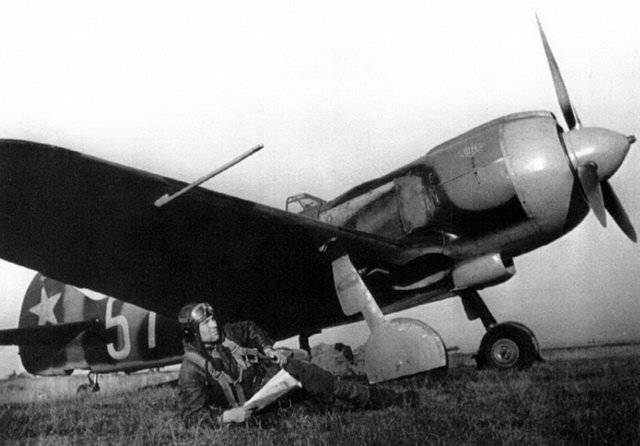
Armament fighter consisted of 2-x synchronous guns ShVAK caliber 20-mm with pneumatic and mechanical reloading. The total ammunition equaled 340 shells. For aiming at the target used collimator sight PBP-la. On aircraft La-5FN additionally installed wing bomb racks, which were designed for the suspension of bombs weighing up to 100 kg.
In addition to the standard set of monitoring and flight-navigation instruments, the equipment of the fighter included an oxygen instrument, a short-wave radio station RSI-4 and a landing light. The oxygen supply was enough for an 1,5 flight hour at an altitude of 8000 m.
The letters FN in the marking La-5FN were interpreted as Forced Direct Fuel Injection and belonged to the engine. This aircraft began to arrive in the army in March 1943. Its engine ASH-82FN developed maximum power in 1850 HP. and could withstand the forced mode for 10 minutes of flight. This version of the La-5 fighter was the fastest. On the ground, the car accelerated to 593 km / h, and at an altitude of 6250 meters it could reach speed in 648 km / h. In April, the 1943 of the year in the Moscow Region of Lyubertsy took place a series of air battles between the La-5FN and the captured fighter Bf.109G-2. Training battles demonstrated the overwhelming superiority of the La 5 in speed at low and medium altitudes, which were fundamental to the air battles of the Eastern Front.
La-7
The La-7 was a further upgrade of the La-5 fighter and one of the best production vehicles of the end of World War II. This fighter had excellent flight qualities, high maneuverability and good armament. At low and medium altitudes, he had an advantage over the latest piston fighters of Germany and the countries of the anti-Hitler coalition. La-7, on which Kozhedub ended the war, is currently located in the Central Museum of the Russian Air Force in the village of Monino.
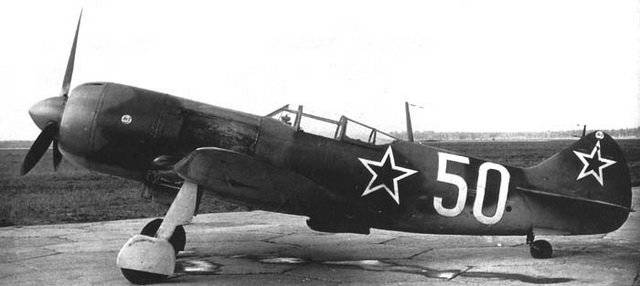
In appearance and size, the fighter was very slightly different from the La 5. One of the significant differences were spars, which, as in the last series of La-5FN, were made of metal. In this case, the skin and ribs of the aircraft remained unchanged. The dimensions of the cross section of the side members were reduced, which made it possible to free up additional space for the fuel tanks. The weight of the fighter side members decreased by 100 kg. The aerodynamics of the fighter significantly improved, this was achieved, in particular, by transferring and improving the shape of the radiator. The internal sealing of the aircraft was also improved through the complete elimination of gaps between the pipes and their openings in the fire compartment and the gaps in the hood. All these improvements allowed the La-7 to gain an advantage over La-5 in flight speed, climb rate and maximum ceiling. The maximum speed of the La-7 was 680 km / h.
Two 7-mm ShVAK guns or 20 3-mm B-20 guns could be installed on the La-20 as weapons. The guns had hydromechanical synchronizers, which prevented the projectiles from getting into the propeller blades. Most of the La-7, like the La-5, was armed with two ShVAK cannons, which had 200 ammunition for ammunition on the barrel. The composition of the ammunition fighter included armor-piercing incendiary and fragmentation-incendiary shells weighing 96 grams. Armor-piercing incendiary projectiles at a distance of 100 meters pierced along the normal armor thickness up to 20 mm. bombs weighing up to 100 kg could be suspended on the two wing assemblies of the fighter.
Sources used:
www.warheroes.ru/hero/hero.asp?Hero_id=403
www.airwar.ru/enc/fww2/la5.html
www.airwar.ru/enc/fww2/la7.html
Materials free online encyclopedia "Wikipedia"
Secrets of the century. Two wars of Ivan Kozhedub
Information